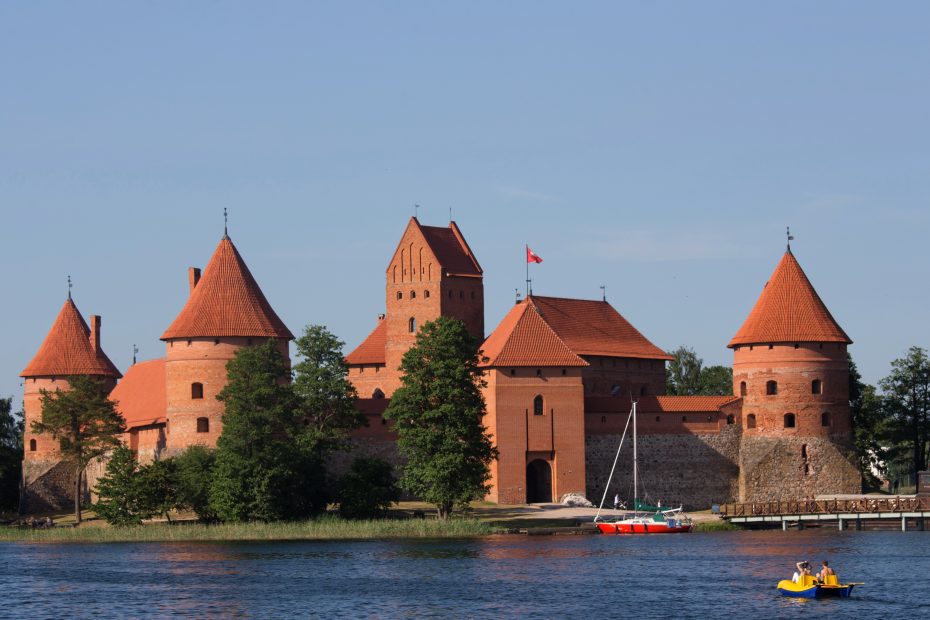Perched on an island in Lake Galvė, the magnificent red brick walls of Trakai Castle offer a glimpse into Lithuania’s medieval past. As the former seat of power for the Grand Duchy of Lithuania, Trakai Castle holds deep cultural significance for the Lithuanian people. Visiting this island fortress transports you back in time to the days of knights, dukes, and battles with the Teutonic Knights.
The foundations of Trakai Castle were laid in the 14th century, when Grand Duke Kęstutis chose the strategically important location to defend against crusading German knights. Situated between Vilnius and Kaunas on the shores of Lake Galvė, Trakai Castle occupied a prime defensive position that controlled important trade routes. Construction began around 1350, with additional structures and towers added by Kęstutis’ son Vytautas the Great. The distinctive Brick Gothic architecture lent an imposing, impregnable aura to the castle.
Architectural Highlights
Trakai Castle is an outstanding example of medieval Brick Gothic architecture. The outer defensive walls are supplemented by inner fortifications separating the castle into two main sections. Each section has its own gates, towers, posterns, and battlements. The most iconic feature is the tall, slender Kęstutis Tower rising high above the waters of Lake Galvė. Other highlights include the Birutės Tower, the Peninsula Castle built on a former island, and the restored facades of the Ducal Palace.
Inside the castle walls, visitors can explore rooms that offer a window into medieval life. The cavernous Grand Hall features soaring cross vaults and gives insight into the grandeur of ceremonies and feasts. The bedchambers provide a more intimate look at ducal living quarters with period furnishings. The castle houses an impressive collection of medieval weaponry and artifacts that allow you to envision preparations for battle and defense of the castle. The reconstructed Ducal Office shows where the administration of the Grand Duchy took place.
Trakai Town
Just across a footbridge lies historic Trakai Town, its picture-perfect houses and shops lining the pedestrian street Kęstutis. Take time to meander through town, stopping for traditional Lithuanian fare at cozy cafes and bakeries. An intriguing feature of Trakai is the presence of the Karaite minority, bringing diversity to this lakeside retreat. Karaites are a Turkic-speaking ethnoreligious group that adheres to Karaite Judaism.
The town provides an idyllic setting next to the castle, and its proximity to Vilnius makes Trakai an appealing day trip destination. Visitors often marvel at the peaceful, romantic atmosphere of this medieval town seemingly frozen in time.
Visiting Trakai Castle
Trakai Castle is open year-round, with longer summer hours. Entry fees are reasonable, and audio guides are available to enrich your experience. Multiple buses run daily between Vilnius and Trakai, taking about 30-50 minutes each way. Tour companies also offer convenient day trips. Once there, a free shuttle boat provides transportation across Lake Galvė to the castle. Allow 2-3 hours to fully take in the main castle sights and exhibition.
Cultural Significance
More than just fascinating history and architecture, Trakai Castle holds deep meaning for the Lithuanian people. It represents the pinnacle of power during the glory days of the medieval Grand Duchy, a source of national pride. The destruction and restoration of the castle parallels the story Lithuania itself – once a formidable European power battered by war and occupation, now showing renewed prosperity and identity after regaining independence.
Trakai Castle brings Lithuanian history to life. While much of the country’s medieval heritage was destroyed, this island fortress authentically preserves the atmosphere of Lithuania’s past grandeur. Now a popular tourist attraction, it links the present to the nation’s cultural roots.
Restoration and Preservation
Given its strategic significance, Trakai Castle unsurprisingly suffered damage from wars and neglect over the centuries. After the Lithuanian Wars of Independence in the 1920s, restoration efforts began. However, World War II and Soviet occupation brought further destruction. Major reconstruction projects in the 1960s and 1980s restored the castle to its former glory. Trakai Castle earned its listing as a UNESCO World Heritage Site in 2005, recognizing its immense cultural value.
Ongoing preservation ensures future generations can experience the unique majesty of Trakai Castle. Wandering its grounds and towers, you travel back 700 years to the days of medieval knights and lords. This iconic Baltic castle continues to inspire awe and fascination.
Conclusion
A journey to Trakai Castle provides an unforgettable trip back in time. The soaring red brick walls rising from the waters transport you to the 14th century Grand Duchy and bring Lithuanian history alive. Beyond the striking architecture and medieval exhibits, Trakai Castle holds deep cultural meaning for the Lithuanian people. The meticulous restoration celebrates Lithuania’s heritage and national identity. For an immersive experience of Lithuania’s enchanting past, Trakai Castle is a must-see Baltic destination.
FAQ
- What style of architecture is Trakai Castle?
Trakai Castle showcases Brick Gothic architecture with features like tall, narrow windows, imposing brick walls, vaulted ceilings, and high towers.
- Who originally built Trakai Castle?
Grand Duke Kęstutis began construction on Trakai Castle in the mid-14th century and his son Vytautas the Great continued expanding it.
- What purpose did Trakai Castle serve?
Trakai Castle was strategically built to help defend the Grand Duchy of Lithuania from the Teutonic Knights. It served as a residence, administrative center, and military stronghold.
- When can you visit Trakai Castle?
Trakai Castle is open daily with longer summer hours from April to October. The castle grounds can be visited year-round but interior access is limited in winter.
- How do you get to Trakai Castle from Vilnius?
Frequent daily buses run between Vilnius and Trakai, taking around 30-50 minutes. Organized day trips provide transportation or you can drive about 28km to Trakai.
